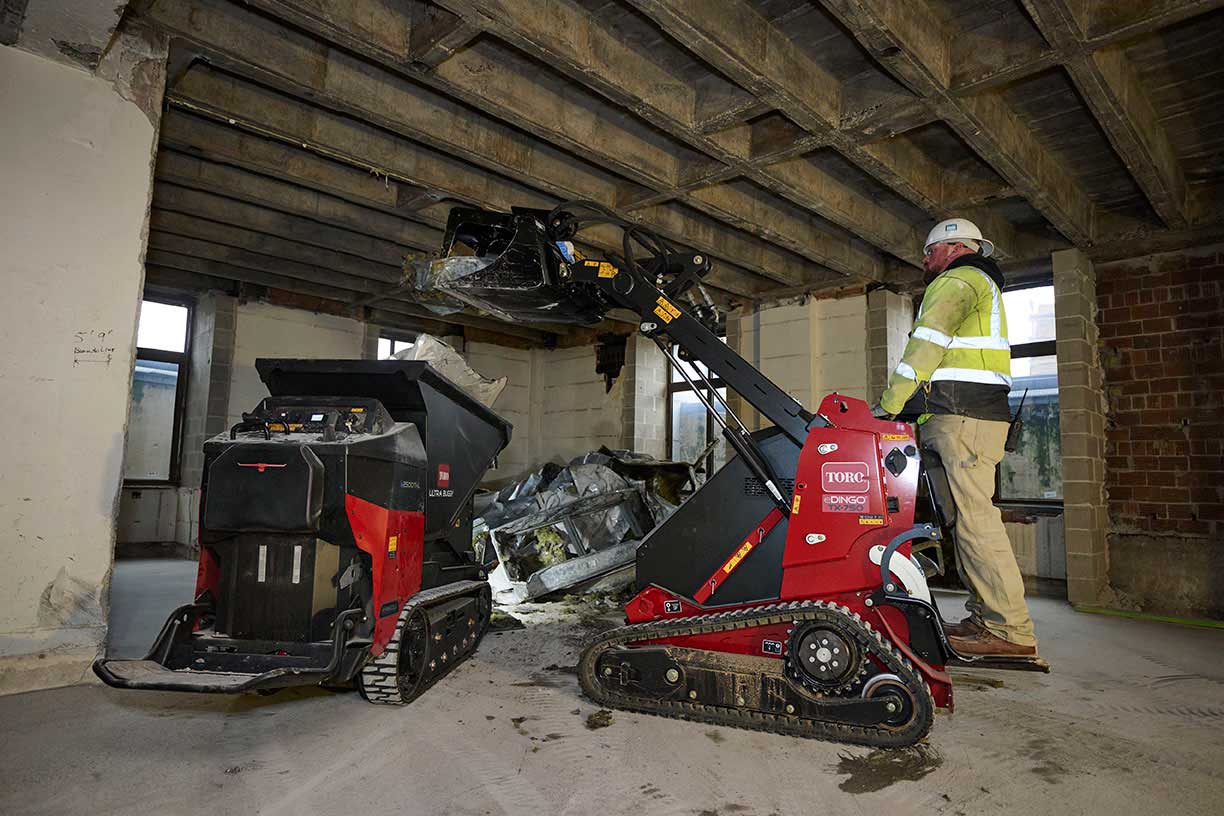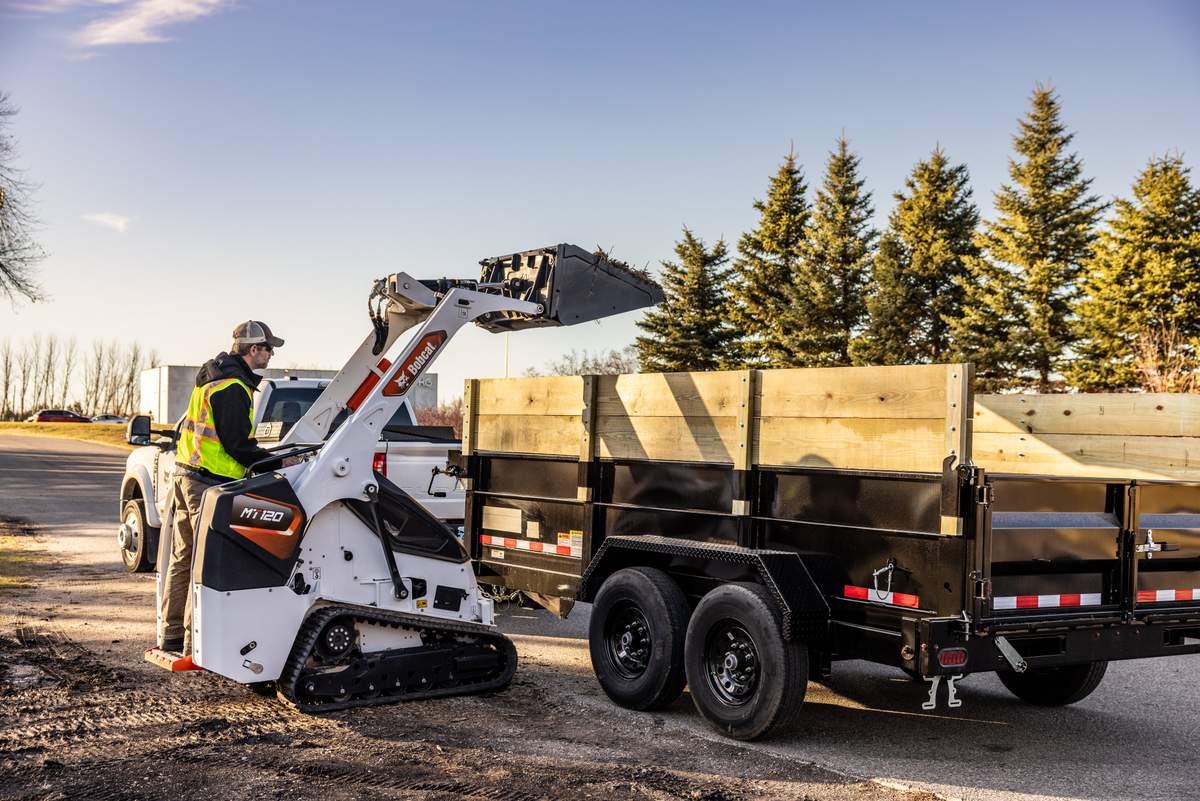Learn More About Compact Tool Carriers + Get Advice from 12 Manufacturers

One of the smallest categories of attachment takers is the compact tool carrier. Some units even have a gas engine or an electric variant. Sometimes called mini skid steers, compact utility loaders or stand-on track loaders depending on the manufacturer, compact tool carriers personify the big power and small footprint trend of compact equipment. Even more so, over the last 20-plus years, compact tool carriers have morphed from wheeled, medium-power supplemental equipment to track-driven, spec-heavy jobsite project leaders. The size, power and versatility of compact tool carriers have significantly increased sales over the decades.
Today, manufacturers such as Toro, Bobcat, Ditch Witch, Kubota, Case, Vermeer and Wacker Neuson are all selling compact tool carriers. Think of them as skid steers or track loaders without a cab. They use a similar universal quick-attachment plate (some can even wield a skid steer quick-attach plate), they come on wheels and tracks and they have a zero turning radius that’s ideal for tight quarters. Buyers have a bevy of options: stand-on and walk-behind units; hydraulic flow rates from 8 to 22 gpm; gas, diesel and electric engines; wheels or dedicated track undercarriages; and a zillion different attachments (buckets, breakers, brooms, blades, backhoes and box scrapers, and that’s just the Bs).
These units are not necessarily cheap (most falling in the $14,000 to $40,000 price range). In fact, units have gotten as large as small skid steers — like Ditch Witch’s monstrous SK3000 and Toro’s Dingo TXL 2000 (the latter has a telescoping version). So, before you choose to buy one, it’s wise to do your homework.
To help you even further, we contacted nearly every compact tool carrier manufacturer in the industry to share some advice for owners, operators and potential buyer/renters. Here’s what they came up with…
Toro

Toro’s senior marketing manager Sam Dando says that the biggest piece of advice for customers is to make sure you choose the right tool for the job. He encourages customers to consider these questions when looking for the perfect machine:
- First, consider the site and the task at hand. Is the space tight or are there hard-to-reach places that create a need for maximum maneuverability through features like true spin-turn or four-wheel drive?
- Are tracks needed?
- What operating capacity and lift height are required?
- Would a ride-on or walk-behind configuration be a better solution?
- Is there a need for zero engine exhaust emissions?
- Are there any auxiliary attachment requirements or uses?
Ditch Witch

“When purchasing a new stand-on skid steer, contractors should consider machine maintenance and use cases,” says Brant Kukuk, Ditch Witch product manager. “Contractors will want to bring machines into their fleet that require easy and minimal maintenance. Additionally, contractors should consider the use cases and jobsite requirements for their new machines. For example, smaller stand-on skid steers are great for residential projects, as they are compact enough to maneuver through gates and minimize yard damage, while larger stand-on skid steers afford contractors with the horsepower and weight to lift and move heavier loads. Depending on the attachments you’ll be using, the skid steer will also need to be a certain weight to counter the load.”
Kubota

“As with any piece of construction equipment, there is no such thing as being too aware of your surroundings. Being aware of people and equipment around you is critical to safety on any jobsite,” says Jerry Corder, Kubota product manager, construction equipment. “Additionally, as compact utility loaders [CULs] are on the narrow side, it is necessary to stay conscious of the slope you are working on, especially with a load, or when turning. And just like with a compact track loader, when you have a load, make sure you have room to avoid sudden stops. Lastly, it is imperative to understand the proper way to load and unload the machine and its attachments for any CUL. Most CUL’s have limitations on approach and departure angles.”
Case Construction Equipment

“When looking at adding a mini track loader to your fleet, consider the value these machines can offer your business,” says Ryan Anderson, product manager, MTL, SAL, Case Construction Equipment. “For example, enabling your operators to take on work in smaller spaces where they previously couldn’t with bigger machines. Almost as important, pay close attention to ergonomics. Be mindful of how the control layout and operator platform impact the operator’s comfort and performance. Pay close attention to these details. Look for comfortable operator-first stations and smooth controls so they can have better control response and greater confidence.”
Wacker Neuson

“Be mindful of the total cost of ownership, not just cost and frequency of maintenance but also ease of maintenance,” says Doug Clark, product manager, compact equipment, at Wacker Neuson. “Downtime is costly, and both the infrequency of breakdown and maintenance and also speed of maintenance can result in great improvements with regard to the profitability of your business.”
Gravely

Gravely channel marketing manager Angie Ansorge says potential buyers should keep these factors in consideration:
- Controls: Opting for a CUL with a self-leveling boom can streamline operation, especially for operators less familiar with such equipment, thus reducing the learning curve.
- Attachments: Universal attachment plates facilitate versatility and accommodating various accessory types.
- Operational Ease: The streamlined design of CULs simplifies operation by minimizing unnecessary controls and levers, making them more user-friendly.
Bobcat

“Consider purchasing versus renting attachments for use with mini track loaders,” says Mike Fitzgerald, marketing manager for Bobcat. “Not only will various attachments have the versatility to work on both a mini track loader and select larger compact loaders, but an attachment will pay for itself after only a few projects because of increased productivity and time saved versus doing the work by hand.”
Vermeer

“When operating mini skid steers, remember that while their tight turning radius makes them flexible in different work scenarios, it’s best to avoid making sharp turns whenever possible,” says Kyle Newendorp, product specialist at Vermeer. “Sharp turns can potentially damage softer surfaces like grass and can also lead to premature wear and tear on tracks or tires. If possible, try to make your turns more gradual, as this can help minimize the need for restoration work.”
Kanga Loaders

“As compact utility loaders vary highly in their models and application, some questions before buying might help guide you in the right direction,” explains Rod Lehpamer, Kanga Loaders general manager. “For example, consider the size of your workspace. Is it confined or narrow? Are there height restrictions? Do you have a preferred engine type — gas or diesel? Other key factors to consider are how long the brand has been in the industry and if they offer after-sales service and support. A good tip to finding the perfect loader is always asking for a demonstration of the product. If after considering all the above, you still aren’t sure, read customer testimonials on social media or industry related forums.”
Volteq Equipment

“When considering purchasing electric-powered machines, it’s crucial to evaluate your specific needs,” says Patrik Psenak, CEO of Volteq. “Can you achieve the required runtime between charges? Ensure charging is convenient and accessible, especially with integrated chargers, which can be plugged into standard 120V outlets. Electric machines consume no energy when the machine is idle but not in use, feature immediate slow speed control and deliver instant torque for better responsiveness and precise, controlled movements. Reduced operating and maintenance costs of electric machines are significantly decreasing the total cost of ownership over time, making them a compelling investment. Additionally with features like minimized vibration, zero emissions, lower noise and remote control, operators can work more safely and efficiently.”
Altoz

“When looking at equipment, it is important to look at the functional capabilities, financial return and safety benefits,” says Karl Bjorkman, Altoz vice president of sales and revenue. “Demo the product and make sure the controls are ergonomically correct and intuitive and that you have 360-degree visibility. Confirm the ease of connectivity of the different attachments. A variety of attachments can perform multiple tasks and increase productivity and profitability. Finally, make sure the equipment is comfortable to operate and provides a safer, more efficient way to accomplish the task at hand.”
New Holland Construction

“It is always important to research and compare specifications and competitive offerings, as well as consider long term costs,” says Dan Kakareka, New Holland Construction product marketing manager. “Remember, purchasing any equipment is a significant decision. Take your time, do your research and don’t hesitate to ask questions and seek expert advice before making your final choice.”




